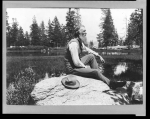Today in History: July 19
John Muir
Watching the daybreak and sunrise. The pale rose and purple sky changing softly to daffodil yellow and white, sunbeams pouring through the passes between the peaks and over the Yosemite domes, making their edges burn; the silver firs in the middle ground catching the glow on their spiry tops, and our camp grove fills and thrills with the glorious light. Everything awakening alert and joyful…John Muir,
Entry for "July 19" from
My First Summer in the Sierra, 1911.
"California As I Saw It": First-Person Narratives of California's Early Years, 1849-1900

John Muir,
1902.
The Evolution of the Conservation Movement, 1850-1920
On July 19, 1869, naturalist John Muir set pen to paper to capture his experience of awakening in the Sierra Nevada Mountains of California. Published in 1911, My First Summer in the Sierra is based on Muir's original journals and sketches of his 1869 stay in the vicinity of the Yosemite Valley. His journal tracks his three-and-a-half-month visit to the Yosemite region and his ascent of Mt. Hoffman and other Sierra peaks. Along the way, he describes the flora and fauna as well as the geography and geology of the area.
Muir immigrated from Scotland to Wisconsin as a child. He attended the University of Wisconsin and began working as a mechanical inventor. After an 1867 industrial accident nearly blinded him, he abandoned his career as an inventor to work as a naturalist.

El Capitan,
Yosemite Valley,
California,
William Henry Jackson, photographer,
1899.
Touring Turn-of-the-Century America: Photographs from the Detroit Publishing Company, 1880-1920
An early defender of the environment, Muir in 1876 advocated adoption of a federal forest conservation program. His popular articles and books describing Yosemite's natural wonders inspired public support for the establishment of Yosemite National Park in 1890 and expansion of the park in 1906. At the same time, Muir continued to work and write as a serious scientist whose fieldwork in botany and geology enabled him to make lasting contributions. Alaska's Muir Glacier is named for him. In 1892, Muir co-founded the Sierra Club as an association explicitly dedicated to wilderness preservation and served until 1914 as its first president, shaping it into an organization whose leadership in political advocacy for protection of the natural world continues to this day.
The popularity of President Theodore Roosevelt's groundbreaking conservation program owed much to Muir's writing. In 1903 Roosevelt and Muir visited the Yosemite region together. In 1908, Roosevelt issued a presidential proclamation establishing the Muir Woods National Monument in Marin County, California, in Muir's honor. Muir died six years later. Although sorrow and disappointment at his failure to save Hetch Hetchy Valley from becoming a reservoir for San Francisco may well have contributed to his death, Muir had succeeded more than any other single individual in establishing the preservation of wild nature as a major American cultural and political value. The clarity of his vision and the eloquence of his writing continue to inspire environmentalists throughout the world.
Learn more about John Muir and the conservation movement in American Memory:
- Search the following collections on John Muir to locate works by Muir, including The Mountains of California, My First Summer in the Sierra, and his autobiography, The Story of My Boyhood and Youth:
- Search on John Muir in Built in America: Historic American Buildings Survey/Historic American Engineering Record, 1933-Present for photographs and drawings of Muir's home, now a National Historic Site.
- Visit the Sierra Club's John Muir Exhibit. This fascinating presentation provides a wealth of information and links, including many photographs, a wide selection of electronic texts written by and about John Muir, and sound clips of songs written about or inspired by Muir's work.

Yosemite National Park Wildflowers,
Yosemite National Park,
California.
American Landscape and Architectural Design, 1850-1920 - Search on Yosemite or the name of other national parks in the following collections to see more images of America's natural wonders:
- American Environmental Photographs, 1891-1936: Images from the University of Chicago Library
- Touring Turn-of-the-Century America: Photographs from the Detroit Publishing Company, 1880-1920
- American Landscape and Architectural Design, 1850-1920: a Study Collection from the Harvard Graduate School of Design
- The Evolution of the Conservation Movement, 1850-1920
- Visit Yosemite National Park online via the National Park Service.
- Search on conservation or national park in the Today in History Archives to find features on milestones in the history of conservation in America. Topics include the establishment of the National Park Service in 1916, the 1908 Governors' Conference on the Conservation of Natural Resources, the creation of national parks in Washington (Mt. Rainier National Park) and Maine (Acadia National Park), and the first celebration of Earth Day.
- For access to current environmental protection bills under consideration in the U.S. House of Representatives and the Senate, visit THOMAS and browse major legislation classified by topic using terms such as environmental protection or public lands.
The Seneca Falls Convention
Among the many important questions which have been brought before the public, there is none that more vitally affects the whole human family than that which is technically called Woman's Rights.Elizabeth Cady Stanton,
"Address Delivered at the Seneca Falls Convention,"
July 19-20, 1848.
Votes for Women: Selections from the National American Woman Suffrage Association Collection, 1848-1921
On July 19, 1848, the First Woman's Rights Convention began in Seneca Falls, New York. The idea of holding such a meeting had originated eight years earlier in London, England, when Elizabeth Cady Stanton, Lucretia Mott, and other women delegates were barred from participating in the 1840 World Antislavery Convention.
The real planning and preparation for the event took place at a couple of meetings that occurred just a few days before the convention. On July 9, 1848, Stanton, Mott, Martha C. Wright, Jane Hunt, and Mary Ann McClintock met over tea and decided to hold a conference to promote women's rights. They placed an unsigned announcement in the Seneca County Courier advertising a Woman's Rights convention to be held on Wednesday, July 19, and Thursday, July 20. On the first day of the convention only women were allowed to attend; the second day, the general public was invited to join the meeting.

Lucretia Coffin Mott,
between 1860 and 1880.
By Popular Demand: "Votes for Women" Suffrage Pictures, 1850-1920

Elizabeth Cady Stanton
and her Daughter Harriot,
from a daguerreotype,
1856.
By Popular Demand: "Votes for Women" Suffrage Pictures, 1850-1920
On Sunday, July 16, some of the women met again to discuss an agenda. They began to draft a "Declaration of Sentiments." Through the eve of the Convention, Stanton continued to write and revise the "Declaration" which she modeled after the Declaration of Independence:
When, in the course of human events, it becomes necessary for one portion of the family of man to assume among the people of the earth a position different from that which they have hitherto occupied, but one to which the laws of nature and of nature's God entitle them, a decent respect to the opinions of mankind requires that they should declare the causes that impel them to such a course…"Declaration of Sentiments,"
The First Convention Ever Called to Discuss the Civil and Political Rights of Women,
Seneca Falls, New York, July 19, 20, 1848.
Votes for Women: Selections from the National American Woman Suffrage Association Collection, 1848-1921
On the morning of July 19, the meeting convened at the Wesleyan Church. Nearly 300 people responded to the invitation. Stanton read the "Declaration's" preamble, eighteen grievances, and a list of resolutions calling for moral, economic, and political equality. Defying social pressures to remain quietly in the background, Stanton listed the ways women were subjugated by men:
He has never permitted her to exercise her inalienable right to the elective franchise.
He has compelled her to submit to laws, in the formation of which she had no voice.
He has withheld from her rights which are given to the most ignorant and degraded men--both natives and foreigners.
Having deprived her of this first right of a citizen, the elective franchise, thereby leaving her without representation in the halls of legislation, he has oppressed her on all sides.
He has made her, if married, in the eye of the law, civilly dead.
He has taken from her all right in property, even to the wages she earns.
"Declaration of Sentiments,"
The First Convention Ever Called to Discuss the Civil and Political Rights of Women,
Seneca Falls, New York, July 19, 20, 1848.
Votes for Women: Selections from the National American Woman Suffrage Association Collection, 1848-1921
Additional grievances listed in the "Declaration" concerned church matters and interpretation of scriptures, issues of deep concern to Stanton. After giving voice to their indignation at the oppression of women, Stanton and Mott proposed a series of resolutions designed to realize the "Declaration's" radical notion that "all men and women are created equal."
To learn more about the resolutions passed at the Seneca Falls Convention select the Today in History feature for July 20, the second day of the convention.

Election Day!
1909.
By Popular Demand: "Votes for Women" Suffrage Pictures, 1850-1920
Learn more about the woman suffrage movement in American Memory:
- The "Declaration of Sentiments," resolutions, and excerpts from Stanton's address are online in The First Convention Ever Called to Discuss the Civil and Political Rights of Women available through Votes for Women: Selections from the National American Woman Suffrage Association Collection, 1848-1921. This collection documents the suffrage campaign with 167 books, pamphlets, and other artifacts gathered from the archives of National American Woman Suffrage Association (NAWSA) collection held in the Rare Book and Special Collections Division of the Library of Congress.
- Additional American Memory collections documenting the woman suffrage campaign include:
- American Women: A Gateway to Library of Congress Resources for the Study of Women's History and Culture in the United States is simultaneously a guide, an online magnet for digitized women's history materials drawn from a plethora of Library sources, and a gateway. One section of the guide describes the Women's Suffrage collections held by the Manuscript Division.
- Enjoy William Lloyd Garrison's "supplement" to Scotsman Robert Burns's poem "A Man's a Man, For A' That" (1794). Garrison's adaptation "Human Equality," in America Singing: Nineteenth-Century Song Sheets, urges the cause of women's rights.
- Search the Today in History Archive on suffrage to find relevant features on leaders of the woman's rights movement such as Susan B. Anthony, Lucretia Mott, Elizabeth Cady Stanton, and Alice Paul. View the features about men such as Frederick Douglass and Bronson Alcott who gave their support to the woman's rights movement.
- The Teachers Page offers the special presentation "Women Pioneers in American Memory" as well as a Collection Connections guide to the historical period covered in the collection Votes for Women: Selections from the National American Woman Suffrage Association Collection, 1848-1921.
- To learn more about Seneca Falls as a historic landmark, see the National Park Service's site Women's Rights National Historical Park.